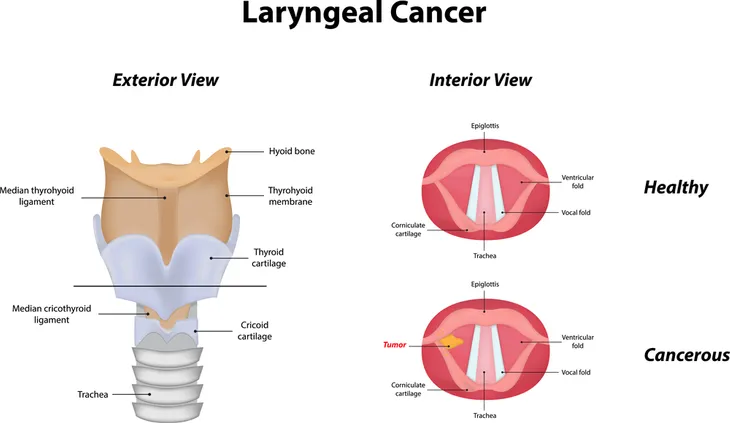The throat is a muscular tube that runs between our head and neck. It starts behind the nose and ends in the neck. Like any other area of the body, the throat is also susceptible to cancer. Throat cancer often begins in the flat cells inside the throat, which eventually turn into cancerous tumors in the throat (pharynx), voice box (larynx), or tonsils.
While throat cancer is relatively rare, especially when compared to other cancers, it’s still something we should be aware of because it tends to grow quickly. Seeking treatment as early as possible provides the best chances at survival and a decent quality of life. According to the National Cancer Institute, about 1.2-percent of adults in the U.S. are estimated to have been diagnosed with oral cavity and pharyngeal cancers in their lifetime. Another o.3-percent of adults will be diagnosed with laryngeal cancer in their lifetime.
Here’s a look at everything to know about this cancer, including the symptoms, causes, and treatment options…
Types of Throat Cancer
There are several different types of throat cancer. All of them are defined by the development and growth of abnormal cells, but they can be categorized based on where they appear in the throat. This helps decide what will be the best and most effective treatment plan. WebMD explains that most throat cancers grow in the flat, thin cells lining the throat and voice box. However, there are other areas where cancerous tumors can grow.
The two primary types of throat cancer are squamous cell carcinoma and adenocarcinoma, says Healthline. These types can be further categorized as to where they occur, either in the pharyngeal or laryngeal area of the body. The pharynx is the hollow tube that runs from the nose to the top of the windpipe. Pharyngeal cancers may occur in the following areas:
- Nasopharynx: This type of cancer is rare in the U.S. It occurs in the upper part of the throat behind the nose.
- Oropharynx: Located behind the mouth. This cancer is likely to grow in the tonsils, back of the tongue, or soft palate.
- Hypopharynx: Narrow area behind the voice box.
The second category of throat cancer is laryngeal cancer which forms in the larynx (also known as the voice box).
Throat cancer can also occur in the glottics (holds the vocal cords), supraglottic (area above the glottis), or subglottic (area below the vocal cords and above the windpipe) area, adds the source.
Signs and Symptoms
There are a number of common signs and symptoms for throat cancer, but (for the most part) it will depend on where the tumor is located and the type of cancer. Here’s a look at some of the most general symptoms of throat cancer.
Sore Throat
Not surprisingly, one of the most common symptoms associated with throat cancer is pain or discomfort in the throat which can also be categorized as a sore throat (and is referred to as pharyngitis in clinical terms). This pain usually won’t go away on its own and cannot be soothed by any of the usual remedies for a sore throat. (Here’s a look at all the Potential Causes For Your Sore Throat).
Voice Changes
Since throat cancer can occur in the larynx (or voice box), it can also cause some changes in the voice. These changes pertain to the sound and volume of the voice. According to Memorial Sloan Kettering Cancer Center, “it may be quieter, husky, or sound as if you have a cold all the time.” You might also begin to slur your words or have trouble pronouncing certain words or sounds.
Trouble Swallowing
Another common symptom of throat cancer is trouble swallowing (or dysphagia in clinical terms). This can be especially prominent if the tumor is quite large and is dependent on where it is located in the throat. You might also experience a burning sensation or some pain while chewing and swallowing food. The Memorial Sloan Kettering Cancer Center says food can also get stuck in the throat.
Lump in the Neck
Throat cancer may cause enlarged or swollen lymph nodes which results in a visible lump in the neck.”Swelling in one or more lymph nodes in the neck is a common symptom of throat cancer, as well as other head and neck cancers,” notes the Memorial Sloan Kettering Cancer Center.
If you find any lumps that don’t go away on their own, it might be worth getting them checked out by your doctor. Cancer typically forms as a lump and slowly gets bigger over time, says the source.
Weight Loss
Weight loss is one of the most common symptoms across the board with cancer. It occurs in many different types of cancer, and throat cancer is no exception. Due to the fact that throat cancer can make swallowing and chewing food more painful and difficult, people with this type of cancer may experience a change in eating habits. They’ll likely eat less, which then causes weight loss. (Here’s a look at some more Health Conditions Linked to Weight Loss).
Other Signs
In addition to the above symptoms, someone with throat cancer might experience trouble opening their mouth and trouble moving their tongue, as well as white patches on the tongue that don’t go away, says the Memorial Sloan Kettering Cancer Center. Other symptoms include chronic cough, coughing up blood (hemoptysis), nosebleeds (epistaxis), ear pain, and headaches.
You should make an appointment to see your doctor if any of these symptoms occur and remain persistent over time. Most of these symptoms on their own aren’t related to cancer, but if you experience one or more and they don’t go away, it might be worth having a doctor investigate further.
Causes and Risk Factors
One of the major risk factors for throat cancer is smoking tobacco for long periods of time. This is by far the biggest risk factor for all head and neck cancers, including throat cancer, says WebMD. Another risk factor is drinking heavily and regularly. Any person who consumes more than two alcoholic drinks per day for men and one alcoholic drink per day for women is at great risk for developing throat cancer. When these two factors are combined, the risk becomes even greater.
Another risk factor is gender, as men are five times more likely than women to develop throat cancer, says WebMD. Age can also play a role in the development of throat cancer, since most people are diagnosed after the age of 65. It’s also been discovered that African American men are at a higher risk, as is those who are exposed to chemicals such as asbestos, nickel, and sulfuric acid fumes.
Other lifestyle habits that may increase the chances of throat cancer in the throat are poor nutrition and poor dental hygiene, as well as genetic syndromes. According to Healthline, throat cancer is also linked to certain types of human papillomavirus (HPV) infections. “HPV is a sexually transmitted virus. HPV infection is a risk factor for certain oropharyngeal cancers,” writes the source.
Treatment
When it comes to treatment, you’ll likely work with a number of specialists, including an oncologist, radiation oncologist, and pathologist. There are several different options for treatment, from radiation to surgery. The method of treatment will likely depend on the severity of your disease, along with some other factors.
Surgery
Smaller tumors may be removed by surgery. This would be done in a hospital while under sedation. Healthline notes there are several different surgical procedures that can be performed. Your doctor will recommend one of the following based on where the cancer is located and the stage of cancer:
- Endoscopic Surgery: This procedure is for early-stage cancers. An endoscope is used to allow surgical instruments or lasers to treat the affected areas.
- Laryngectomy: Doctors may remove the part of the voice box that is affected by cancer. They will try to leave as much of the voice box behind as possible. Depending on the size of the tumor, they may be able to preserve your ability to breathe and speak normally.
- Cordectomy: This surgery removes all or part of the vocal cords.
- Pharyngectomy: If the cancer is small, the doctor may only need to remove a small part of your throat during surgery. Parts that are removed can sometimes be reconstructed to help swallow food normally.
- Neck Dissection: If the cancer has spread deep within the neck, your doctor may be required to remove some or all of your lymph nodes to contain the cancer cells.
Chemotherapy and Radiation
Chemotherapy and radiation is a common form of treatment for all cancers, and throat cancer is no different. This type of treatment is used to kill cancer cells. Chemotherapy is often used alongside radiation when treating throat cancers. “Certain chemotherapy drugs make cancer cells more sensitive to radiation therapy,” writes the Mayo Clinic. “But combining chemotherapy and radiation therapy increases the side effects of both treatments.”
You will need to discuss the side effects of these treatments with your doctor to know whether the combined treatments will offer benefits that outweigh the risks.
Targeted Therapy
Targeted therapy uses drugs to “starve” cancer cells. According to Healthline, “targeted therapies are drugs that stop the spread and growth of cancer cells by interfering with specific molecules that are responsible for tumor growth.” One popular type of targeted therapy is cetuximab (Erbitux) which stops the action of a protein found in healthy cells that is common in certain types of throat cancer cells.
There are other targeted therapies available, but they are only being used in clinical trials. This type of therapy is often used alongside chemotherapy and radiation.
Recovery
It’s extremely important to take care of yourself during the recovery period after treatment. Most of the treatments listed above take a lot out of a person, so it’s important to get lots of rest, exercise when possible, and eat healthy (lots of fruits and veggies). Not surprisingly, you should also quit smoking tobacco and limit alcohol consumption as these can make any treatment less effective, and raise the risk of developing another cancer, says WebMD.
Lastly, it’s important to maintain any follow up appointments with your doctor. Your doctor will likely want to monitor any progress, particularly in the first couple of years after treatment, to look for any signs that the cancer has come back.















